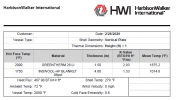- Joined
- Jun 3, 2019
- Messages
- 2,714
Guys,lets please be nice. We all have our unique experience and perspective to draw from. Often we are in agreement, but interpretation of the words chosen produce anger ..
Lets try to keep that in mind please?
as i wanted this thread to be about specific design decisions:
JT - i am really interested about your comment re loading on the coils. That is new to me and would really like to know how that might effect amount of coil needed for a furnace. Can you please clarify or supply a link to go to ti learn more?
Natlek - as one engineer to another: as a given that it is small pockets of trapped air that supplies the real insulation in materials - WHY does kaowool, which is essentially a nonwoven textile (not closed cell foam ... and is permeable to air) have a LOWER thermal conductivity per thickness than brick? Or is it actually closed cell? As a second question, do you really think that loss of heated air when opening door is that significant compared to radiative loss lo the environment through the open door (when you open the door you FEEL that radiation on your face...)
Lets try to keep that in mind please?
as i wanted this thread to be about specific design decisions:
JT - i am really interested about your comment re loading on the coils. That is new to me and would really like to know how that might effect amount of coil needed for a furnace. Can you please clarify or supply a link to go to ti learn more?
Natlek - as one engineer to another: as a given that it is small pockets of trapped air that supplies the real insulation in materials - WHY does kaowool, which is essentially a nonwoven textile (not closed cell foam ... and is permeable to air) have a LOWER thermal conductivity per thickness than brick? Or is it actually closed cell? As a second question, do you really think that loss of heated air when opening door is that significant compared to radiative loss lo the environment through the open door (when you open the door you FEEL that radiation on your face...)






